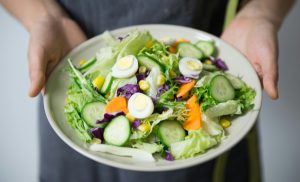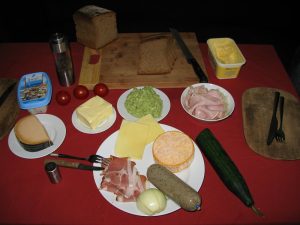6.6 Schwarzes Brot macht Wangen rot

Guten Tag!
Zum Aufwärmen machen wir unseren Tagesminiplausch und eine Wiederholung.
Wiederholung
In the previous lesson, you learned to discuss differences between German and American Frühstück and some food items you might eat in America and Germany. Let’s review what you have learned.
Was isst du zum Frühstück? Answer the question in your written journal by listing the foods you typically eat for breakfast. Then record your answer in your audio journal.
Lektionsüberblick
In both Germany and in the US, we typically talk about having three square meals a day (drei anständige Mahlzeiten), breakfast (Frühstück), lunch (das Mittagessen), and dinner (das Abendessen). As we saw in Lektion 6.5, there are differences between what a traditional breakfast looks like in each country. The midday and evening meals present even bigger differences. Traditionally, Germans eat eine warme Mahlzeit (a warm meal) at the midday meal and eine kalte Mahlzeit (a cold meal) in the evening – the reverse order of the typical American diet.
This lesson will focus on die kalte Mahlzeit, often called Brotzeit (=bread time), because Germans typically have bread with cold cuts and cheeses for dinner. In the end, you will be able to 1) recognize words for die kalte Mahlzeit, 2) say when you eat your kalte Mahlzeit, and 3) say what you typically eat for your kalte Mahlzeit.
1) die kalte Mahlzeit
What foods might be included in die kalte Mahlzeit? Look below for some words you know, as well as new ones. Which words are similar to English? Be sure to click through to the second slide.
Jetzt bist du dran!
2) Ich esse mittags/abends kalt.
Do you ever eat a cold meal for lunch or dinner? Remember the words from past lessons that you have learned to describe frequency. Review those below. Be sure to click through each slide.
Jetzt bist du dran!
Hamburg im Blickpunkt

Die St. Michaelis Kirche (umgangssprachlich: Michel) mit ihrem 132,14 Meter hohen Kirchturm prägt die Silhouette der Stadt und galt schon früh als Orientierungsmarke für die auf der Elbe nach Hamburg segelnden Schiffe. Die Uhr im Kirchturm hat ein Durchmesser von acht Metern und ist die größte ihrer Art in Deutschland. Sie wurde 1911 in Betrieb genommen. Der große Zeiger hat eine Länge von 4,91 Metern und der kleine von 3,65 Metern. Jeder dieser Zeiger wiegt 130 Kilogramm und ist – genauso wie die umgebenden Ziffern – mit Blattgold belegt.

St. Michaelis Church (colloquially: Michel), with its 132.14-meter-high tower (433.5ft), shapes the city’s skyline and had served as a point of orientation for ships sailing up the Elbe toward Hamburg. The clock in the church tower has a diameter of eight meters and is the largest of its kind in Germany. It was put into operation in 1911. The large hand is 4.91 meters (16ft) long and the small one 3.65 meters (12ft). Each of these hands weighs 130 kilograms (286.6lbs) and—like the surrounding numerals—is covered with gold leaf.
3) Ich esse… mittags/abends
Was isst du mittags? Was isst du abends? What do you regularly eat for lunch? For dinner? Let’s talk specifics now. Look at the examples below. – This lesson is focusing on the kalte Mahlzeit. Lektion 6.8 will focus on warme Mahlzeiten (warm meals)
 |
 |
 |
| Ich esse einen Salat mittags. | Ich esse ein belegtes Brot abends. | Ich esse eine Suppe mittags. |
Let’s practice.
Jetzt bist du dran!
Zum Schluß


*As you conclude this lesson, don’t forget to check Canvas!*
Before you go!
Check out this related content:

Media Attributions
- 1010-1020 banner long large reduced
- Photo of salad by pexels-catscoming-406152
- Photo of sandwich by pexels-brigitte-tohm-36757-186861
- Photo of soup by pexels-jentstyle-photo-3559899
- Private: confidence scale_large horizontal_updated

